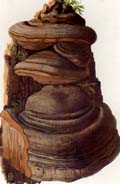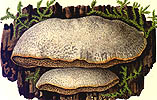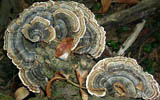 Key to Gilled Mushrooms Key
Key to Gilled Mushrooms KeyThis is a key to gilled mushrooms, that is, mushrooms having a definite cap with a fertile surface consisting of gills. The fruiting body usually also has a stem, although that may be lateral or absent (usually, then, the mushroom is growing from wood). You can use this key to identify mushrooms that you find.
 Polyporaceae Family
Polyporaceae FamilyFertile surface usually a layer of vertical tubes, of which the mouths are visible as pores on the underside of the cap or shelf.
Fruiting bodies usually tougher or harder than the "normal" gilled mushrooms, being leathery, corky, or woody. But they can be quite tender while actively growing
Once grown, they do not decay easily, remaining on the substrate for months or years
They often grow on wood, although a few are terrestrial (even those are usually growing on buried wood)
Fruiting body is usually a flat shelf, or hoof-shaped, protruding directly from the substrate, although sometimes it may have a short stalk.
Some forms never grow away from the substrate at all, so that all that is visible of the fruiting body are the pores.
Sometimes the pores are so minute that the fertile surface seems solid, until you look closely
 Lignicopolypore Subfamily
Lignicopolypore SubfamilyGrowing on wood
Sessiloporus TribeNot fitting the other choices, not stipitate
In making choices below based on texture and size, place the emphasis on texture: if left alone, some of the smaller ones can eventually get quite big; and even the huge ones have to start out small at first
 Small Sessilopolypore Subtribe
Small Sessilopolypore SubtribeIndividual caps small (max. 2-3" across)
Soft or tough, but not hard when fresh, although they may become hard when they dry out
All thin-fleshed fruiting bodies go here, especially if compound or imbricate
 Small Imbricate Polypore SemiTribe
Small Imbricate Polypore SemiTribeFruiting in dense clusters of thin-fleshed shelving fruiting bodies
Purplish-tubed Polypore SemiHemiTribe
Diagnosis
- Developing pore surface reddish or purple
-
Cap white, often furry
-
Upper context loose and fibrous, except in the most common species :-)
Narrow down your identification:
Gloeoporus Genus- Pore surface reddish at first, soon purple, darkening or dulling with age
-
Pores not breaking up into teeth in age
-
Cap with a (proportionately) wide, white, cottony sterile margin
 Trichaptum Genus
Trichaptum Genus- Hymenophore and cap margin bright purple when actively growing; fading to lilac or lavender, eventually to buff
-
Tube walls usually breaking up into a daedaleoid or (more often) toothlike formation
-
Fruiting body clearly duplex: lower layer denser and darker than the upper layer






 Key to Gilled Mushrooms Key
Key to Gilled Mushrooms Key Polyporaceae Family
Polyporaceae Family Small Sessilopolypore Subtribe
Small Sessilopolypore Subtribe




